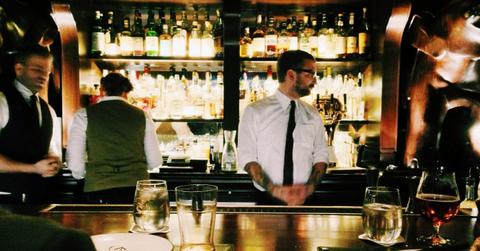 NEWS
NEWSHow to Become a Great Bartender in the US

Nov. 26 2024, Published 1:56 a.m. ET
Becoming a bartender in the United States is an exciting career path that combines creativity, interpersonal skills, and the opportunity to work in dynamic environments. Whether you’re drawn to the artistry of crafting cocktails or the thrill of a fast-paced bar, bartending offers a fulfilling profession with flexibility and growth potential. Here’s everything you need to know about stepping into this vibrant field.
Job description
At its core, bartending involves mixing and serving alcoholic beverages to customers. Bartenders are the heart of any establishment’s social scene, fostering connections and creating memorable experiences for patrons. Beyond pouring drinks, their responsibilities often include:
A bartender's role involves crafting cocktails and experimenting with drink recipes to offer unique and enjoyable experiences to patrons. This includes serving beverages either directly to customers or through waitstaff while efficiently managing payments and maintaining accurate cash registers. Ensuring compliance with alcohol regulations is a crucial aspect of the job, alongside keeping the bar area clean, organized, and well-stocked with supplies to guarantee smooth operations.
Bartenders work in a variety of settings, including restaurants, bars, nightclubs, hotels, and event venues. Some specialize in high-end cocktail creation, while others thrive in casual, high-volume establishments.
Work environment
Bartending is as challenging as it is rewarding. The job often demands long hours, including evenings, weekends, and holidays. During peak times, bartenders must juggle multiple orders, maintain a friendly demeanor, and ensure accuracy under pressure. The physical demands of the job are substantial, requiring prolonged periods of standing, the lifting of heavy items such as kegs or cases of beverages, and the repetitive motions involved in tasks like shaking, pouring, and garnishing drinks.Despite these challenges, many bartenders find the fast-paced environment invigorating and the social interactions deeply satisfying.
Education, training, and certifications
One of the most appealing aspects of bartending is that formal education is not required. Most bartenders learn their craft on the job, honing skills like mixing techniques, customer service, and inventory management through hands-on experience. However, there are certain prerequisites and recommendations for aspiring bartenders:
Age requirements
- In most states, bartenders must be at least 18 years old to serve alcohol. Some establishments may set the age limit at 21.
Licensing
- Twenty-two states require a license to serve alcohol. Common certifications include:
- RBS (Responsible Beverage Service)
- TIPS (Training for Intervention Procedures)
- ServSafe Alcohol Certification
Bartending courses
- While not mandatory, completing a bartending course can give candidates a competitive edge. Online schools, such as Drinksworld, offer certifications recognized across the industry. These courses cover essential topics like mixology basics, customer service, and safety protocols.
For those passionate about mixology, specialized training in crafting unique cocktails or learning about different spirits can pave the way to roles in upscale bars or as beverage consultants.
Salary and earnings
Bartender wages vary significantly depending on location, establishment type, and experience level. The median hourly wage for bartenders in the U.S. is $15.15, translating to an annual median salary of $31,510. However, tips play a significant role in total earnings. With tips, bartenders typically earn between $19,870 and $61,210 annually, averaging $37,090.
Want OK! each day? Sign up here!
Regional variations
Location greatly impacts earning potential. For example:
- New York City: Base pay ranges from $41,000 to $68,000, with tips adding up to $26,000.
- Las Vegas: Bartenders earn $34,000 to $55,000 in base pay, with tips contributing an additional $21,000 to $39,000.
- California: Average salaries hover around $48,000, with some reaching up to $60,000.
High-volume or luxury establishments typically offer higher earning opportunities, especially in bustling urban centers or tourist destinations.
Job outlook
The demand for bartenders is on the rise. Employment in this field is projected to grow 9% from 2023 to 2033, significantly faster than the average for all occupations. This growth will result in approximately 134,600 job openings annually over the decade.
This growth is driven by several key factors, including the reopening and expansion of hospitality venues following the pandemic, a rising consumer interest in craft cocktails and unique bar experiences, and the growing trend of bars and restaurants offering alcohol-free beverages, which is opening new opportunities for innovation.
Demographics and workforce composition
With over 711,140 bartenders employed across the United States, the profession showcases remarkable diversity in age, gender, and ethnicity. Women make up 60.5% of the workforce, while men account for 39.5%. The average age of female bartenders is 30, slightly younger than their male counterparts, whose average age is 34. In terms of ethnicity, 65% of bartenders identify as White, 19% as Hispanic or Latino, and 5.6% as Black or African American. This blend of demographics underscores the inclusive and adaptable nature of the profession, embracing individuals from a wide range of backgrounds.
Employment by industry
Bartenders find opportunities across a range of industries, with the majority employed in restaurants and eating places, which account for 319,880 positions. Drinking establishments specializing in alcoholic beverages follow, employing 182,100 bartenders. Other sectors, such as traveler accommodations, civic and social organizations, and beverage manufacturing, offer additional roles, with 43,530, 37,320, and 35,400 positions, respectively. While restaurants dominate the market, niche opportunities are also available in breweries, wineries, and catering companies, catering to more specialized or unique customer experiences.
Steps to start your bartending career
If bartending sounds like the right fit for you, here are the steps to get started:
- Meet Age Requirements: Ensure you meet the minimum age to serve alcohol in your state.
- Obtain Licensing: Complete any required alcohol service certifications.
- Gain Experience: Start in entry-level roles, such as a barback, to learn the ropes.
- Enroll in Bartending School: Consider online courses or in-person training to build foundational skills.
- Network: Connect with industry professionals and seek mentorship from experienced bartenders.
- Build Your Resume: Highlight customer service experience and a passion for hospitality.
Becoming a bartender in the United States is more than just a job—it’s a dynamic career that offers creativity, flexibility, and the chance to connect with people from all walks of life. With a positive job outlook and diverse opportunities across industries, bartending is an excellent choice for those seeking a fast-paced, rewarding profession. Whether you’re mixing mojitos at a bustling city bar or crafting signature cocktails at a luxury resort, bartending opens doors to a world of possibilities.


